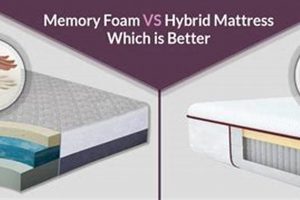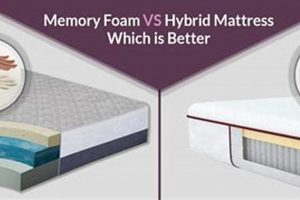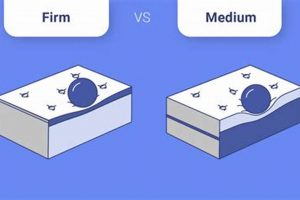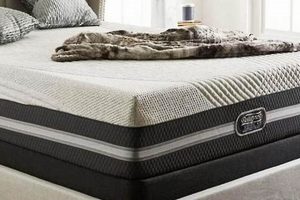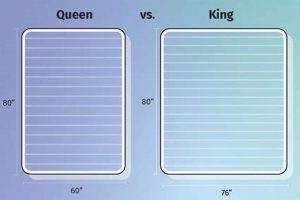The classification of mattresses often includes measurements of their thickness, typically expressed in inches. A common point of comparison involves models that are 10 inches versus those that are 12 inches in height. This difference in profile can influence the overall feel and suitability of a mattress for different individuals and sleep preferences.
The height of a mattress can significantly impact factors such as ease of getting in and out of bed, the level of support provided, and the mattress’s ability to accommodate different body weights. Historically, thicker mattresses were often associated with greater luxury and comfort, though modern manufacturing has allowed for thinner mattresses to offer comparable support through advanced materials and construction techniques.
This article will delve into the specific characteristics and potential advantages and disadvantages related to mattress profiles of differing heights, exploring how varying mattress thicknesses contribute to the overall sleep experience. This will allow consumers to make informed decisions based on individual needs and preferences.
Guidance on Mattress Selection
Considering mattress height is essential for optimizing sleep quality and overall comfort. The following recommendations address the implications of choosing between mattress profiles.
Tip 1: Assess Bed Frame Compatibility: Ensure the chosen mattress height aligns with the existing bed frame. A lower profile frame may benefit from a thicker mattress to achieve a comfortable bed height, while a taller frame may necessitate a thinner mattress.
Tip 2: Evaluate Body Weight and Support Needs: Individuals with higher body weights may require a thicker mattress to ensure adequate support and prevent bottoming out. Lighter individuals may find sufficient support in a thinner model.
Tip 3: Consider Sleep Position: Side sleepers may benefit from a thicker mattress to allow for greater pressure relief on the hips and shoulders. Back and stomach sleepers may find adequate support with a slightly thinner option.
Tip 4: Factor in Ease of Entry and Exit: The combined height of the bed frame and mattress should allow for comfortable and easy entry and exit from the bed, particularly for individuals with mobility limitations.
Tip 5: Acknowledge Partner Preferences: If sharing a bed, consider the preferences of both individuals regarding mattress height and its impact on comfort and support.
Tip 6: Evaluate Sheet Fit: Mattress height impacts the necessary pocket depth of fitted sheets. Confirm compatibility between mattress thickness and sheet dimensions to ensure a proper fit.
Tip 7: Budget Considerations: While not always the case, thicker mattresses may sometimes carry a higher price point due to the increased materials used in construction.
In summary, thoughtful consideration of personal needs and circumstances is critical in determining the optimal mattress thickness. Addressing these factors promotes informed decision-making.
Moving forward, a deeper dive into the materials used in different mattress heights will further inform the selection process.
1. Support Layer Depth
Support layer depth directly correlates with the overall height of a mattress and plays a crucial role in determining its suitability for various individuals. The difference in support layer depth between a 10-inch and a 12-inch mattress significantly impacts factors such as comfort, spinal alignment, and pressure relief.
- Core Stability
The depth of the support layer dictates the core stability of the mattress. A deeper support layer, found in a 12-inch model, typically provides more robust support for the sleeper, preventing excessive sinking and promoting proper spinal alignment. This is especially relevant for individuals with higher body mass or those who prefer sleeping on their back or stomach. In contrast, a shallower support layer in a 10-inch mattress may offer less resistance and could be more suitable for lighter individuals.
- Material Density
A deeper support layer often translates to a higher density of support materials, such as high-density foam or innerspring coils. This increased density enhances the mattress’s ability to withstand prolonged use without significant degradation of support. A 12-inch mattress, with its potentially denser support layer, may exhibit greater longevity compared to a 10-inch model if the core material are better.
- Pressure Distribution
The support layer contributes significantly to how weight is distributed across the mattress surface. A thicker support layer can more effectively distribute weight, reducing pressure points and minimizing discomfort, particularly in areas such as the hips and shoulders. This is especially beneficial for side sleepers who require adequate cushioning to maintain spinal alignment. A 10-inch mattress with a thinner support layer may concentrate pressure in these areas, leading to discomfort or pain.
- Motion Isolation
While typically associated with comfort layers, the support layer also influences motion isolation. A deeper and denser support layer can absorb and minimize the transfer of motion, preventing disturbances caused by a sleeping partner’s movements. A 12-inch mattress may offer superior motion isolation compared to a 10-inch model if the construction of the support layer is engineered for this purpose.
In essence, the depth of the support layer is a fundamental consideration when choosing between mattress heights. Selecting a mattress that provides adequate support for individual body weight, sleeping position, and comfort preferences is essential for promoting restful and restorative sleep. The differences between 10-inch and 12-inch mattresses in terms of support layer depth highlight the importance of assessing individual needs and prioritizing the features that align with those requirements.
2. Overall Bed Height
The overall height of a bed, comprising the bed frame, foundation (if applicable), and mattress, is a significant factor influencing ease of access and aesthetic appeal. The choice between a 10-inch or 12-inch mattress directly impacts this overall height. A 12-inch mattress, for instance, will elevate the sleeping surface by two inches compared to a 10-inch model, assuming all other components remain constant. This seemingly small difference can have practical implications.
For individuals with mobility limitations or those of shorter stature, a lower bed height is often preferable to facilitate easier entry and exit. Conversely, taller individuals may find a higher bed more comfortable, reducing strain on their knees and back. Consider an elderly person with arthritis who might struggle to climb onto a bed with a combined height exceeding 25 inches. Alternatively, a younger, taller individual might find a bed with a height of only 18 inches uncomfortably low. These examples illustrate the importance of carefully considering the combined height based on individual physical needs and preferences. Furthermore, the overall bed height affects the visual balance of the bedroom. A very thick mattress on a low platform bed might appear disproportionate, while a thin mattress on a high bed frame could seem inadequate.
In conclusion, the selection between a 10-inch and 12-inch mattress is not solely about mattress comfort; it is intrinsically linked to the resulting overall bed height and its impact on accessibility, ergonomics, and the aesthetic harmony of the sleeping environment. Careful assessment of individual needs and physical capabilities, coupled with an awareness of design principles, is essential for making an informed decision. The challenge lies in achieving a balance between mattress comfort and practical considerations related to bed height.
3. Material Quantity
Material quantity, specifically the volume of materials used in construction, is a distinguishing factor when comparing 10-inch and 12-inch mattresses. The difference in height directly translates to a variation in the amount of foam, coils, and fabric integrated into each mattress type, influencing several performance and cost aspects.
- Core Component Volume
A 12-inch mattress generally incorporates a greater volume of core components, such as support foam, memory foam, or innerspring coils, compared to a 10-inch model. This increased material volume can contribute to enhanced support, improved pressure relief, and potentially greater durability, depending on the quality of materials used. For example, a 12-inch mattress might contain an additional layer of high-density foam in the support core, providing increased resistance to sagging and deformation over time.
- Upholstery and Comfort Layer Density
Beyond the core components, material quantity also affects the density and thickness of upholstery and comfort layers. A thicker mattress profile often allows for a more substantial comfort layer, providing a plusher feel and potentially better contouring to the body. This is especially relevant for side sleepers who require adequate cushioning around the hips and shoulders. A 10-inch mattress, with its limited height, may offer a less pronounced comfort layer, resulting in a firmer sleep surface.
- Impact on Manufacturing Costs
The quantity of materials directly influences manufacturing costs. A 12-inch mattress, requiring more raw materials, will typically have a higher production cost compared to a 10-inch mattress of similar construction quality. This difference in cost may translate to a higher retail price for the consumer. However, the additional material may also contribute to enhanced performance and longevity, potentially justifying the higher investment.
- Weight and Handling
Increased material quantity invariably leads to a heavier mattress. A 12-inch mattress will typically weigh more than a 10-inch mattress of comparable design. This difference in weight can affect ease of handling, installation, and rotation. Consumers should consider the weight of the mattress, particularly if they anticipate moving it frequently or have limited physical strength. Delivery can become harder due to the increased volume of the larger mattress.
In conclusion, the quantity of materials is a fundamental differentiating factor between 10-inch and 12-inch mattresses, impacting performance characteristics, manufacturing costs, and handling considerations. Understanding these material-related distinctions is crucial for consumers seeking to make informed purchase decisions based on their individual needs and preferences.
4. Edge Support Strength
Edge support strength refers to the ability of a mattress edge to withstand compression and maintain its shape under pressure. It is a crucial factor influencing the usable sleep surface and overall durability. The mattress height, as differentiated by 10-inch versus 12-inch models, has a direct correlation with the potential for robust edge support. Higher profile mattresses may offer design advantages that impact edge stability.
- Coil System Integration
Mattresses featuring innerspring coil systems can leverage coil gauge and edge reinforcement technologies. A 12-inch mattress may accommodate a more robust perimeter coil system compared to a 10-inch model. Encasing the perimeter with higher gauge steel or utilizing a denser arrangement of coils enhances resistance to edge collapse. This is important as a weakened edge reduces usable sleep surface and facilitates roll-off. Individuals sharing a bed, or those who frequently sleep near the edge, benefit from this design.
- Foam Encasement Density
Foam-based mattresses frequently incorporate foam encasement to provide edge support. The density and thickness of this foam layer can be amplified in a 12-inch mattress due to its increased vertical space. Higher density foam provides greater resistance to compression, maintaining a firmer edge. This is critical for facilitating sitting on the edge of the bed without significant sinkage and for providing a stable surface for dressing or other activities. Thicker foam around the perimeter prevents premature wear in this high-stress area, extending the life of the mattress.
- Layer Construction and Composition
The overall layer construction influences edge support. A 12-inch mattress permits more complex layering and the inclusion of specialized materials. For instance, additional support layers or reinforced foam can be strategically placed near the edge to bolster stability. The arrangement and composition of internal layers in a 12-inch mattress can be optimized to create a more rigid and supportive perimeter than in a 10-inch model with fewer layering options.
- Long-Term Durability and Sag Prevention
Consistent edge support contributes to the long-term durability and sag prevention of the mattress. Repeated compression of the edges, particularly from sitting, can lead to structural degradation and sagging over time. A mattress with enhanced edge support, often facilitated by the increased height of a 12-inch model, resists this wear and tear. Preserving edge integrity maintains the intended comfort and support levels across the entire mattress surface, resulting in a more consistent and longer-lasting sleep experience. Sagging around the edge diminishes the mattress’s structural integrity.
The potential for superior edge support is often associated with the design flexibility afforded by increased mattress height. The specific benefits of a 12-inch model compared to a 10-inch version are dependent on construction and materials. However, understanding the relationship between mattress height and edge support enables consumers to make informed decisions based on individual needs and priorities concerning edge stability and usable sleep surface.
5. Perceived Firmness
Perceived firmness, a subjective assessment of a mattress’s feel under compression, is intrinsically linked to mattress height. The variance in height between a 10-inch mattress and a 12-inch mattress directly influences the composition and arrangement of internal layers, thereby impacting the perceived firmness. A 12-inch mattress, often possessing a thicker comfort layer, may initially present a softer feel compared to a 10-inch mattress with a comparatively thinner comfort layer. This difference in initial impression arises from the greater capacity for cushioning and contouring afforded by the increased material. However, the support core underneath these layers also plays a vital role. A firmer support core in the 12-inch model could counteract the initial softness, resulting in a similar overall firmness level to the 10-inch variant. Therefore, the relationship between mattress height and perceived firmness is multifaceted and contingent upon material properties and construction techniques. Consider a scenario where two mattresses, one 10-inch and one 12-inch, both contain a high-density foam support core. If the 12-inch mattress features an additional layer of plush memory foam, it will likely be perceived as softer than the 10-inch model despite the shared support core.
Understanding this relationship is of practical significance to consumers seeking to align their mattress selection with personal comfort preferences. Individuals requiring a firmer sleeping surface, often those with back pain or stomach sleepers, might find a 10-inch mattress with a relatively thin comfort layer more suitable. Conversely, side sleepers who require pressure relief around the hips and shoulders may benefit from the potentially softer feel of a 12-inch mattress. However, blanket assumptions regarding firmness based solely on height can be misleading. The density and type of materials utilized, alongside the specific layering configuration, are equally important determinants of perceived firmness. Retailers often provide firmness scales to guide consumers, but these ratings are inherently subjective.
In summary, perceived firmness is not simply a direct consequence of mattress height but rather a complex interaction of multiple factors. While a 12-inch mattress may often present a softer initial feel due to increased comfort layer depth, the ultimate perceived firmness depends on the specific materials used, the support core characteristics, and the overall construction. Consumers should, therefore, prioritize a holistic assessment that considers all these elements rather than relying solely on mattress height as a determinant of firmness. Challenges remain in standardizing firmness ratings and providing consumers with consistent and reliable information.
6. Motion Isolation
Motion isolation, the capacity of a mattress to minimize the transfer of movement from one area to another, is a significant factor influencing sleep quality, particularly for individuals sharing a bed. The height of a mattress, as characterized by the “10 inch mattress vs 12” distinction, can have a discernible effect on its motion isolation properties. Increased mattress thickness often allows for more complex layering and a greater volume of motion-dampening materials. A 12-inch mattress, for instance, may incorporate a thicker layer of memory foam or specialized transition foams designed to absorb and dissipate movement. Consider a scenario where one partner frequently changes position during sleep. A mattress with poor motion isolation would transmit these movements, potentially disrupting the other partner’s rest. In this case, the additional material and layering afforded by a 12-inch mattress, if engineered for motion isolation, could prove beneficial.
However, the correlation between mattress height and motion isolation is not absolute. The type and density of materials, as well as the specific construction techniques employed, play critical roles. A 10-inch mattress constructed with high-density memory foam and a strategically designed support core could potentially outperform a poorly designed 12-inch mattress in terms of motion isolation. The internal structure, such as individually pocketed coils, can significantly contribute to minimizing motion transfer, regardless of overall mattress height. A real-world application of understanding this principle involves couples with vastly different sleep schedules or restlessness levels. Choosing a mattress, whether 10-inch or 12-inch, that prioritizes motion isolation can mitigate sleep disturbances and enhance overall relationship harmony. However, a mattress of either height lacking targeted motion isolation design may lead to restless nights.
In summary, while mattress height provides a general indication, motion isolation is primarily determined by material composition and construction. The increased volume and layering options available in a 12-inch mattress can potentially enhance motion isolation. Nevertheless, a thoughtfully designed 10-inch mattress can also achieve excellent motion isolation performance through strategic material selection and construction techniques. Consumers should prioritize understanding the specific materials and construction methods used, rather than solely relying on mattress height as a predictor of motion isolation capability. The challenge lies in effectively communicating these nuanced differences to consumers and providing reliable metrics for comparing motion isolation performance across various mattress models.
Frequently Asked Questions
The following addresses common inquiries concerning the selection of mattress height, specifically differentiating between 10-inch and 12-inch models.
Question 1: How does mattress height impact overall bed height and accessibility?
Mattress height directly contributes to the total bed height. A 12-inch mattress will elevate the sleeping surface 2 inches more than a 10-inch mattress, influencing ease of entry and exit, particularly for individuals with mobility concerns. Individuals should assess their physical needs and bedroom furniture to determine the appropriate mattress height for optimal accessibility.
Question 2: Does a thicker mattress always equate to greater comfort?
Increased mattress height does not guarantee enhanced comfort. Comfort is subjective and depends on factors beyond thickness, including material type, density, and individual preferences. A 12-inch mattress may offer more cushioning but could also be too soft for some. Evaluation of firmness level is crucial, irrespective of height.
Question 3: Can mattress height affect support and spinal alignment?
Mattress height can influence support characteristics. A taller mattress may accommodate thicker support layers, potentially providing greater resistance to compression. However, adequate support depends primarily on the quality and density of the support core, not solely on height. Proper spinal alignment requires a mattress that conforms to the body’s natural curves, regardless of its thickness.
Question 4: Are there advantages to choosing a thinner mattress?
A thinner mattress offers certain advantages. 10-inch models are often lighter and easier to handle than thicker alternatives. They may also be more suitable for platform beds or individuals who prefer a lower sleeping profile. Thinner mattresses can provide adequate support and comfort if constructed with high-quality materials.
Question 5: How does mattress height relate to cost?
Generally, taller mattresses tend to be more expensive due to the increased material used in their construction. However, pricing varies depending on material quality, brand reputation, and retailer markups. The cost-effectiveness of a mattress should be assessed in relation to its performance and durability, not just its height.
Question 6: What considerations are important when choosing between a 10-inch and 12-inch mattress for a shared bed?
When selecting a mattress for couples, consider both partners’ preferences and needs. Factors such as sleeping position, body weight, and desired firmness should be evaluated. Motion isolation is crucial for minimizing sleep disturbances caused by movement. Assessing a mattress’s motion isolation capability is essential for shared sleep environments, irrespective of height.
In summary, mattress height impacts various aspects of the sleep experience, but it is not the sole determinant of comfort, support, or value. A comprehensive evaluation of individual needs and mattress characteristics is essential for informed decision-making.
Further discussion will explore the impact of mattress type, such as memory foam or innerspring, on the selection process.
Conclusion
The preceding discussion has illuminated the multifaceted considerations involved in choosing between a 10 inch mattress vs 12. Mattress height influences factors such as overall bed height, perceived firmness, support, material quantity, and motion isolation. No single mattress height is universally superior; the optimal choice depends on individual needs, preferences, and circumstances. Factors such as body weight, sleeping position, mobility, and budget must be carefully assessed to determine the appropriate mattress height.
Ultimately, the decision requires a thorough evaluation of the interplay between mattress specifications and personal requirements. It is incumbent upon the consumer to prioritize informed decision-making based on a comprehensive understanding of the technical and ergonomic implications of mattress height. This will ensure a satisfactory purchase that promotes restful sleep. Further research into the specific materials and construction techniques employed within mattresses of differing heights is encouraged.


